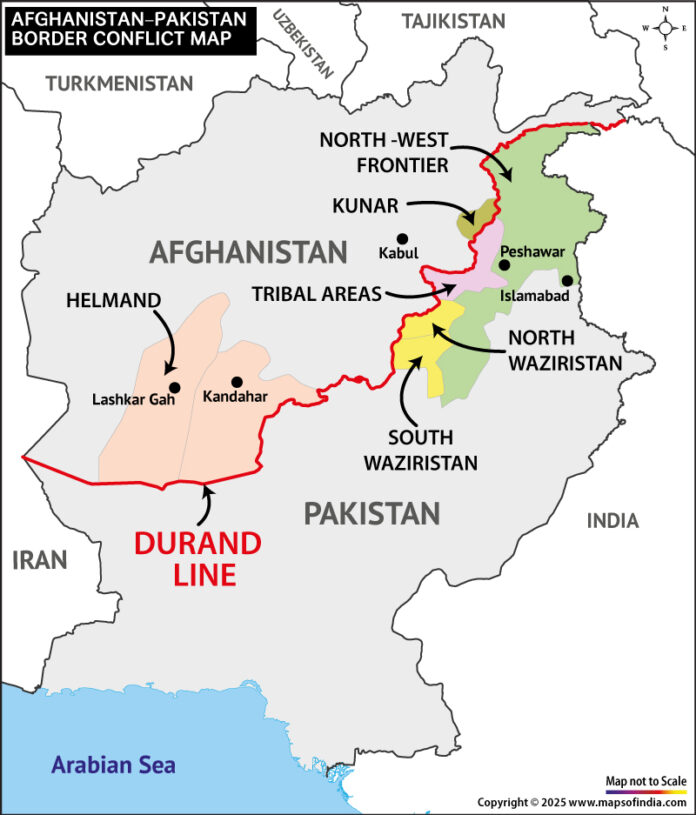The Pakistan and Afghanistan relations were complicated since ancient times – there was a mistrust between the countries, the issue of the new borders and the clash of interests in security. In the recent past, the relationship between the two neighbouring states has escalated more especially along the Durand Line, which is a porous border of 2,670 kilometres between the two countries. The war has escalated to the levels of diplomatic differences to actual clashes between the two nations, with regional and international implications.
This blog chronologically explains the escalations in recent times between Pakistan and Afghanistan, how they happened, along with the underlying factors and how these events have affected the peace and security in the region.
Background: A Border Drawn in Contention
The Pakistan-Afghanistan issue can be dated back to the year 1893, when the Durand Line was formed when the British were in power. This is a boundary that Afghanistan did not recognize as an official boundary since it divides the tribal lands of the Pashtun and disregards ethnic realities. Quite to the contrary, Pakistan considers it an international boundary and has put up fences to control the movement and prevent transnational militancy.
Following the Taliban’s regaining power in Afghanistan in August 2021, the two countries initially were optimistic that there would be stability. Pakistan had been a long-time proponent of a friendly government in Kabul. These hopes were, however, short-lived because border security, militant sanctuaries and cross-border attacks reemerged, causing the tensions.
Timeline of Escalations
2021: Post-Taliban Takeover Strains
After the Taliban took over power, Pakistan was hoping that they would collaborate in the fight against the activities of the Tehreek-e-Taliban Pakistan (TTP), the group that has carried out a number of attacks within Pakistan. Rather, the Taliban position seemed ambivalent. Kabul was alleged by Islamabad to have TTP fighters, whom the Afghan government disavowed.
Skirmishes had started along the border crossings like Chaman-Spin Boldak and Torkham, with both sides trading bullets over the fencing and checkpoints. The number of civilians killed on either side started to increase, and this marked a new strain.
2022: Rising Border Violence
In 2022, the tensions between the two countries escalated when Pakistan unleashed airstrikes on supposed TTP hideouts within Afghanistan’s Khost and Kunar provinces. These strikes were condemned by the Afghan Taliban, who claimed that they violated their sovereignty.
Things got out of control, and there were protests in multiple cities of Afghanistan and Pakistan still insisted that it was in self-defence. Common border closures also occurred in the year that disrupted the trade and stranded civilians, intensifying the mistrust and damaging the two economies.
Diplomacy, such as negotiations between the intelligence and military leaders, did not bear any permanent fruit. It was followed by the blame game of hosting the militants throughout the year.
2023: The Return of Deadly Clashes
By the end of 2023, there were increased tensions in the years. Direct clashes took place regularly on the border between Chaman and Spin Boldak, and it was heard that gunfire and shelling had taken place. Various Afghan civilians and Pakistani soldiers were killed.
Taliban was accused by Pakistan of facilitating the safe havens of TTP fighters who attacked in Khyber Pakhtunkhwa and Balochistan. On the other hand, the Taliban charged Pakistan with exerting military force rather than dialogue.
The trade routes were also closed on several occasions, crippling the cross-border trade. The failed relations led Pakistan to restrict its visa policy and deportations of illegal Afghan refugees, which further damaged humanitarian relations.
2024: Escalation Beyond Borders
In the year 2024, the conflict widened its scope. Pakistan also heightened military actions along the border areas and erected new checkpoints. In its turn, Kabul strengthened the border with Taliban forces and armoured cars.
Cases of cross-border artillery fire and drone surveillance turned out to be common. Thousands of Afghans fled across the border villages to avoid fighting, and this aggravated the humanitarian situation.
In mid-2024, Pakistan alleged that some of the terrorist attacks in its territory had been orchestrated across the Afghan border, including in the lethal attack in Bannu. The Taliban government denied such allegations, terming them baseless. Diplomatic contacts were again frozen, the two camps calling in ambassadors and trading sharp words.
2025: The Current Standoff
The border situation is still strained in 2025. Occasional firing is still going on on the crossings of the Chaman and Torkham, and Pakistan has had a tight security policy. The deportation of Afghan refugees (who are decades old, with some having lived in Pakistan) has attracted international objections.
Kabul has threatened that this will be detrimental to bilateral relations. In the meantime, Pakistan has maintained that security issues should be prioritized due to the increasing attacks by the TTP-related militants who are stationed in the Afghan territory.
The effort of the regional powers such as China and Iran to intervene between the two nations has been moderately successful so far. Lack of an established communication system has placed both countries on high alert, and chances of a greater face-off are always looming.
Underlying Causes of Conflict
- Militant Safe Havens: Pakistan accuses Afghanistan of providing safe refuge to TTP fighters, and Kabul accuses Islamabad of providing anti-Taliban forces.
- Durand Line Dispute: The denial of the border by Afghanistan is also one of the barriers.
- Refugee and Trade Issues: In Pakistan, the number of refugees is extreme and frequent interference in trade brings dissatisfaction to the Afghans.
- Regional Power Dynamics: Peace is also a more difficult issue as a result of the rivalry between India, China, and the U.S.
The Road Ahead
Without a system of mutual trust and an official border control mechanism, experts suppose that the conflict between Pakistan and Afghanistan may continue to undermine South Asia. The two nations are culturally, ethnically, and economically close to each other, yet there is a long history of distrust between them.
It will also take joint counter-terrorism efforts, open dialogue, and respect for the sovereignty of each other to bring peace. The cooperation of the regions under such schemes as the Shanghai Cooperation Organization (SCO) might also offer a way to reconciliation.
To date, the border is still a tense ground, but the civilians have suffered the consequences of the aggressiveness. Whether Islamabad and Kabul are able to find a common ground will determine whether their bilateral relations will be saved or not, as well as the stability of the region as a whole.





